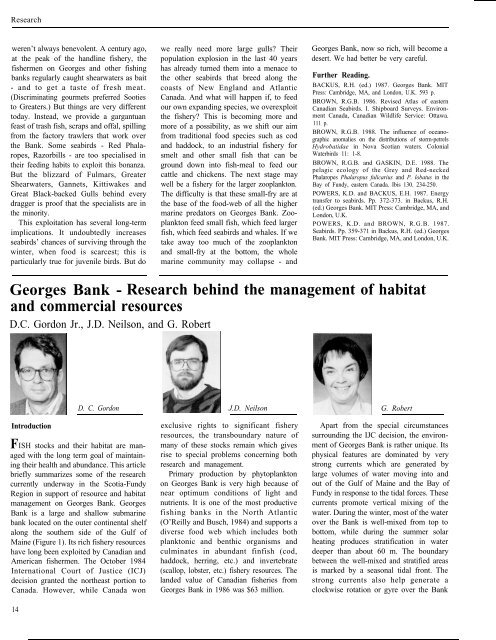SCIENCE REVIEW 1987 - Bedford Institute of Oceanography
SCIENCE REVIEW 1987 - Bedford Institute of Oceanography
SCIENCE REVIEW 1987 - Bedford Institute of Oceanography
Create successful ePaper yourself
Turn your PDF publications into a flip-book with our unique Google optimized e-Paper software.
Research<br />
weren’t always benevolent. A century ago,<br />
at the peak <strong>of</strong> the handline fishery, the<br />
fishermen on Georges and other fishing<br />
banks regularly caught shearwaters as bait<br />
- and to get a taste <strong>of</strong> fresh meat.<br />
(Discriminating gourmets preferred Sooties<br />
to Greaters.) But things are very different<br />
today. Instead, we provide a gargantuan<br />
feast <strong>of</strong> trash fish, scraps and <strong>of</strong>fal, spilling<br />
from the factory trawlers that work over<br />
the Bank. Some seabirds - Red Phalaropes,<br />
Razorbills - are too specialised in<br />
their feeding habits to exploit this bonanza.<br />
But the blizzard <strong>of</strong> Fulmars, Greater<br />
Shearwaters, Gannets, Kittiwakes and<br />
Great Black-backed Gulls behind every<br />
dragger is pro<strong>of</strong> that the specialists are in<br />
the minority.<br />
This exploitation has several long-term<br />
implications. It undoubtedly increases<br />
seabirds’ chances <strong>of</strong> surviving through the<br />
winter, when food is scarcest; this is<br />
particularly true for juvenile birds. But do<br />
we really need more large gulls? Their<br />
population explosion in the last 40 years<br />
has already turned them into a menace to<br />
the other seabirds that breed along the<br />
coasts <strong>of</strong> New England and Atlantic<br />
Canada. And what will happen if, to feed<br />
our own expanding species, we overexploit<br />
the fishery? This is becoming more and<br />
more <strong>of</strong> a possibility, as we shift our aim<br />
from traditional food species such as cod<br />
and haddock, to an industrial fishery for<br />
smelt and other small fish that can be<br />
ground down into fish-meal to feed our<br />
cattle and chickens. The next stage may<br />
well be a fishery for the larger zooplankton.<br />
The difficulty is that these small-fry are at<br />
the base <strong>of</strong> the food-web <strong>of</strong> all the higher<br />
marine predators on Georges Bank. Zooplankton<br />
feed small fish, which feed larger<br />
fish, which feed seabirds and whales. If we<br />
take away too much <strong>of</strong> the zooplankton<br />
and small-fry at the bottom, the whole<br />
marine community may collapse - and<br />
Georges Bank, now so rich, will become a<br />
desert. We had better be very careful.<br />
Further Reading.<br />
BACKUS, R.H. (ed.) <strong>1987</strong>. Georges Bank. MIT<br />
Press: Cambridge, MA, and London, U.K. 593 p.<br />
BROWN, R.G.B. 1986. Revised Atlas <strong>of</strong> eastern<br />
Canadian Seabirds. I. Shipboard Surveys. Environment<br />
Canada, Canadian Wildlife Service: Ottawa.<br />
111 p.<br />
BROWN, R.G.B. 1988. The influence <strong>of</strong> oceanographic<br />
anomalies on the distributions <strong>of</strong> storm-petrels<br />
Hydrobatidae in Nova Scotian waters. Colonial<br />
Waterbirds 11: 1-8.<br />
BROWN, R.G.B. and GASKIN, D.E. 1988. The<br />
pelagic ecology <strong>of</strong> the Grey and Red-necked<br />
Phalaropes Phalaropus fulicarius and P. lobatus in the<br />
Bay <strong>of</strong> Fundy, eastern Canada. Ibis 130. 234-250.<br />
POWERS, K.D. and BACKUS, E.H. <strong>1987</strong>. Energy<br />
transfer to seabirds. Pp. 372-373. in Backus, R.H.<br />
(ed.) Georges Bank. MIT Press: Cambridge, MA, and<br />
London, U.K.<br />
POWERS, K.D. and BROWN, R.G.B. <strong>1987</strong>.<br />
Seabirds. Pp. 359-371 in Backus, R.H. (ed.) Georges<br />
Bank. MIT Press: Cambridge, MA, and London, U.K.<br />
Georges Bank - Research behind the management <strong>of</strong> habitat<br />
and commercial resources<br />
D.C. Gordon Jr., J.D. Neilson, and G. Robert<br />
Introduction<br />
D. C. Gordon<br />
FISH stocks and their habitat are managed<br />
with the long term goal <strong>of</strong> maintaining<br />
their health and abundance. This article<br />
briefly summarizes some <strong>of</strong> the research<br />
currently underway in the Scotia-Fundy<br />
Region in support <strong>of</strong> resource and habitat<br />
management on Georges Bank. Georges<br />
Bank is a large and shallow submarine<br />
bank located on the outer continental shelf<br />
along the southern side <strong>of</strong> the Gulf <strong>of</strong><br />
Maine (Figure 1). Its rich fishery resources<br />
have long been exploited by Canadian and<br />
American fishermen. The October 1984<br />
International Court <strong>of</strong> Justice (ICJ)<br />
decision granted the northeast portion to<br />
Canada. However, while Canada won<br />
14<br />
J.D. Neilson G. Robert<br />
exclusive rights to significant fishery<br />
resources, the transboundary nature <strong>of</strong><br />
many <strong>of</strong> these stocks remain which gives<br />
rise to special problems concerning both<br />
research and management.<br />
Primary production by phytoplankton<br />
on Georges Bank is very high because <strong>of</strong><br />
near optimum conditions <strong>of</strong> light and<br />
nutrients. It is one <strong>of</strong> the most productive<br />
fishing banks in the North Atlantic<br />
(O’Reilly and Busch, 1984) and supports a<br />
diverse food web which includes both<br />
planktonic and benthic organisms and<br />
culminates in abundant finfish (cod,<br />
haddock, herring, etc.) and invertebrate<br />
(scallop, lobster, etc.) fishery resources. The<br />
landed value <strong>of</strong> Canadian fisheries from<br />
Georges Bank in 1986 was $63 million.<br />
Apart from the special circumstances<br />
surrounding the IJC decision, the environment<br />
<strong>of</strong> Georges Bank is rather unique. Its<br />
physical features are dominated by very<br />
strong currents which are generated by<br />
large volumes <strong>of</strong> water moving into and<br />
out <strong>of</strong> the Gulf <strong>of</strong> Maine and the Bay <strong>of</strong><br />
Fundy in response to the tidal forces. These<br />
currents promote vertical mixing <strong>of</strong> the<br />
water. During the winter, most <strong>of</strong> the water<br />
over the Bank is well-mixed from top to<br />
bottom, while during the summer solar<br />
heating produces stratification in water<br />
deeper than about 60 m. The boundary<br />
between the well-mixed and stratified areas<br />
is marked by a seasonal tidal front. The<br />
strong currents also help generate a<br />
clockwise rotation or gyre over the Bank



